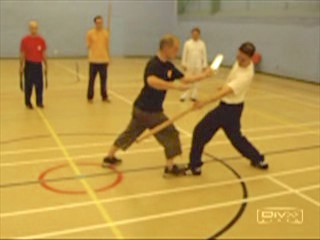FROM SLOW AND SYSTEMATIC TO FAST AND SPONTANEOUS

The Butterfly Knives against the Staff
Others looking at our videos may criticize our combat applications shown here as too slow for actual fighting. We should feel complimented instead of insulted. Although they never mean it, they are actually saying that we understand and practice systematic training whereas they don't.
An analogy may make this clearer. When you first learned how to drive, you didn't go fast. You went over the various necessary maneuvers slowly, not only because you were unfamiliar with them yet, but also this enabled you to perform the movements correctly and smoothly as well as to take note of mistakes made. Now that you know how to drive, these movements have become smooth and fast spontaneously.
Skillful Application of the Sword

Here is how a skillful swordsman would respond to an opponent crossing his Butterfly Knives, then moving in to attack. But the “human-character” formation would frustrate this skillful counter movement of the sword.
Separate Clouds to Search for Silence

Here is another skillful movement of the sword against the reverse slash of the Butterfly Knives. The sword pattern used is the same. It is called “Separate Clouds to Search for Silence”.
Comet Chases after Moon

Sifu Mark demonstrates an effective counter against a thrusting attack from a long weapon, like a staff or a spear. This counter pattern is known as “Comet Chases after Moon”. Notice that Sifu Mark deflects the thrust, not block it.
Counters against a Downward Staff Chop

Sifu Mark shows an effective counter against the downward chop of a staff using the Butterfly Knives pattern called “Point to Star, Look at Moon”. A simpler pattern “Fierce Tiger Descends Mountain” would be better. Do you know why?
Sequence of Continuous Attacks

After deflecting Martin's initial attack, Sifu Mark responds with a series of counters, using the patterns, “Golden Knife Chops Rock”, “Fierce Tiger Descends Mountain” and “Rhinoceros Looks at Moon”. Continuous attacks like these are a forte of Butterfly Knives.
Attacking from the Front-Gate or the Side-Gate

Again Sifu Mark employs a sequence of attacks on an opponent, this time on the other side. In kungfu terms, Sifu Mark attacks from the “in-side” or “front-gate” of the opponent. In the previous video clip he attacked from the “out-side” or “side-gate”. Here the opponent could not defend or counter in time. But if he could, a skillful attack can still continue the planned sequence of attacks, but he needs to make some modifications.
From Slow and Systematic to Fast and Spontaneous in Weapon Training from Wong Kiew Kit on Vimeo.
LINKS
Review of UK Summer Camp 2007 Weapon Course
- Introducing the Butterfly Knives
- Fierce Tiger and Moon-Gazing Rhinoceros
- How would you Counter a Spear Thrust?
- Counters against Chops and Sweeps of Other Weapons
- Butterfly Knives Against a Saber
- The Secret of Performing Butterfly Knives with Force and Speed but Without being Tired
- Yin-Yang Butterfly Knives and Close-Combat Applications
- Some Interesting Applications of Butterfly Knives Held in Reverse
- Combat Training with Weapons Must be Injury Free
- How do you Release your Butterfly Knives from being Locked?
- Learning to Make Flowers Systematically
- Combat Applications of Double Butterflies Flying
- Human-Character and Cross-Road are Found Here
- Kungfu Training and Mental Clarity
- Learning the Combat Applications of the Butterfly Knives against Other Weapons
- The Benefits of Combat Training with Classical Weapons
- From Slow and Systematic to Fast and Spontaneous
- First-Class Kungfu Calls for Great Skills and Techniques
